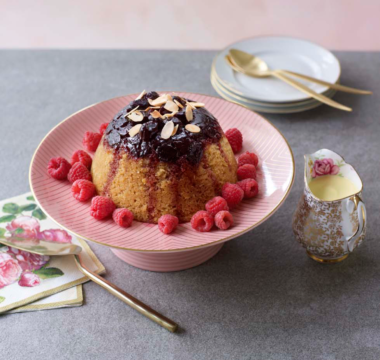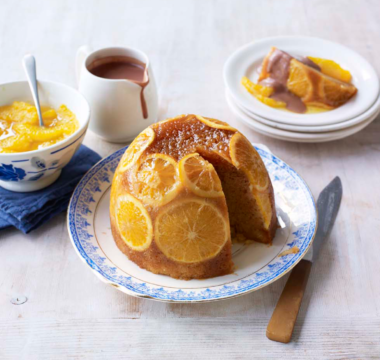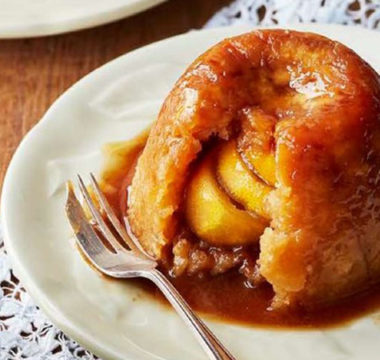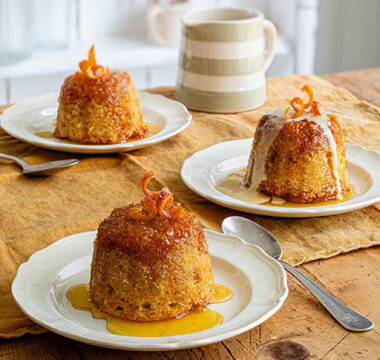The original old-school nursery pudding, there is no lumpy custard here! For all the inevitable amusement it causes, the word ‘dick’ is said to come from an old dialect pronunciation of ‘dough’. And the spots, of course, are the scattering of currants throughout. We’re using vegetable suet here, to make this pudding veggie-friendly, and Prue’s custard is made using double cream as well as milk, for spoonfuls of extra luxury.
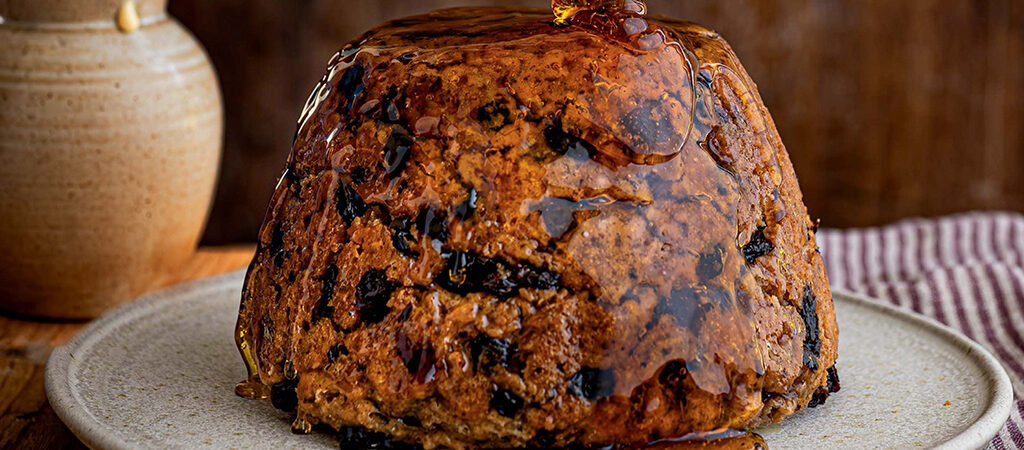

Prue Leith
Series 15
- V
- Ingredients
- Method
Method
Step 1
Make the spotted dick. Tip the currants into a medium heatproof bowl. Add the orange juice and lemon juice and stir together. Cover the bowl with a saucer and place the bowl in a microwave on its highest power for 3 minutes. Remove the bowl from the microwave, remove the saucer, then stir in the bicarbonate of soda and leave the currants to stand for 15 minutes, until plumped up. Alternatively, if you don’t have a microwave, tip the currants, orange and lemon juice into a small saucepan over a medium heat and bring the liquid to the boil. Remove from the heat, stir in the bicarbonate of soda and leave the fruit to soak for up to 3 hours, until plump. Drain the currants through a sieve.
Step 2
Place the flour, cinnamon, baking powder, vegetable suet, brown sugar, orange zest, lemon zest and drained currants into a mixing bowl and mix with a balloon whisk to combine. Add the milk and stir with a wooden spoon to make a soft dough.
Step 3
Spoon the mixture into the buttered basin. Lay a sheet of foil over a sheet of non-stick baking paper (these need to be large enough to cover the top of the pudding bowl). Pick up both and fold a vertical pleat down the centre. Place the foil and paper over the top of the bowl, positioning the pleat down the centre.
Step 4
Tie a piece of string around the edge of the bowl to secure the foil and paper, then tie the string over the top of the bowl and secure it on the other side to make a handle.
Step 5
Place a side plate upside down in the bottom of a large, lidded saucepan and place the pudding basin on top of the plate. Fill the pan two-thirds of the way up with just-boiled water.
Step 6
Cover the pan with the lid, place it on a medium-high heat and bring the water back to the boil. Then, reduce the heat and simmer for 1½ hours, until the foil top has risen a bit and the pleat is stretched slightly.
Step 7
Make the syrup. While the pudding is steaming, tip 50g of the caster sugar into a small saucepan and add 3 tablespoons of cold water. Place the pan over a low heat and stir until the sugar dissolves, then increase the heat to medium and cook to a golden caramel.
Step 8
Remove the pan from the heat and very carefully pour in the just-boiled water (stand back as the caramel will spit a bit). Return the pan to a low heat, add the lemon wedge and remaining 150g of caster sugar, and stir until the mixture comes to the boil. Reduce the heat to its lowest setting and simmer very gently for 20 minutes, until the mixture becomes a light golden colour and has a syrup consistency. Remove the pan from the heat again and set aside until ready to use.
Step 9
Make the custard. Place the milk, cream and vanilla seeds into a pan and bring the liquid to a simmer.
Step 10
Place the egg yolks and sugar into a bowl and whisk together until combined. A little at a time, pour the warm milk mixture onto the eggs, stirring continuously with a balloon whisk. Pour the mixture back into the pan and cook over a low heat, stirring with a wooden spatula, until the custard is just thickened.
Step 11
Once the steaming time is up, use the string handle to carefully remove the pudding basin from the pan. Leave it to cool for 3 minutes, then remove the string, foil and baking paper.
Step 12
Place a serving plate over the top of the basin, then carefully turn out the pudding onto the plate. Re-warm the syrup and pour it over, and serve with the custard.

